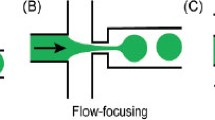Abstract
This paper describes the fabrication of a microfluidic device for use in protein-based bioassays that effectively incorporates poly(ethylene glycol) (PEG) hydrogel microparticles within a defined region. The microfluidic device is composed of a polymerization chamber and reaction chamber that are serially connected through the microchannel. Various shapes and sizes of hydrogel microparticles were fabricated in the polymerization chamber by photopatterning and moved to the reaction chamber by pressure-driven flow. All of the hydrogel microparticles were retained within the reaction chamber due to an in-chamber integrated microfilter with smaller mesh size than hydrogel microparticles. Hydrogel microparticles were able to encapsulate enzymes without losing their activity, and different concentrations of glucose were detected by sequential bienzymatic reaction of hydrogel-entrapped glucose oxidase (GOX) and peroxidase (POD) inside the microfluidic device using fluorescence method. Importantly, there was a linear correspondence between fluorescence intensity and the glucose concentration over the physiologically important range of 1.00–10.00 mM.






Similar content being viewed by others

References
Anderson JR, Chiu DT, Jackman RJ, Cherniavskaya O, McDonald JC, Wu HK, Whitesides SH, Whitesides GM (2000) Fabrication of topologically complex three-dimensional microfluidic systems in PDMS by rapid prototyping. Anal Chem 72:3158–3164
Andersson H, van der Wijngaart W, Enoksson P, Stemme G (2000) Micromachined flow-through filter-chamber for chemical reactions on beads. Sens Actuators B Chem 67:203–208
Bai YL, Koh CG, Boreman M, Juang YJ, Tang IC, Lee LJ, Yang ST (2006) Surface modification for enhancing antibody binding on polymer-based microfluidic device for enzyme-linked immunosorbent assay. Langmuir 22:9458–9467
Bilitewski U, Genrich M, Kadow S, Mersal G (2003) Biochemical analysis with microfluidic systems. Anal Bional Chem 377:556–569
Chovan T, Guttman A (2002) Microfabricated devices in biotechnology and biochemical processing. Trends Biotechnol 20:116–122
Cohen CB, Chin-Dixon E, Jeong S, Nikiforov TT (1999) A microchip-based enzyme assay for protein kinase A. Anal Biochem 273:89–97
Dendukuri D, Pregibon DC, Collins J, Hatton TA, Doyle PS (2006) Continuous-flow lithography for high-throughput microparticle synthesis. Nat Mater 5:365–369
Dodge A, Fluri K, Verpoorte E, de Rooij NF (2001) Electrokinetically driven microfluidic chips with surface-modified chambers for heterogeneous immunoassays. Anal Chem 73:3400–3409
Eteshola E, Leckband D (2001) Development and characterization of an ELISA assay in PDMS microfluidic channels. Sens Actuators B Chem 72:129–133
Figeys D, Pinto D (2000) Lab-on-a-chip: a revolution in biological and medical sciences. Anal Chem 72:330A–335A
Hadd AG, Raymond DE, Halliwell JW, Jacobson SC, Ramsey JM (1997) Microchip device for performing enzyme assays. Anal Chem 69:3407–3412
Hatch A, Kamholz AE, Hawkins KR, Munson MS, Schilling EA, Weigl BH, Yager P (2001) A rapid diffusion immunoassay in a T-sensor. Nat Biotechnol 19:461–465
Jakeway SC, de Mello AJ, Russell EL (2000) Miniaturized total analysis systems for biological analysis. Fresenius J Anal Chem 366:525–539
Jeong WJ, Kim JY, Choo J, Lee EK, Han CS, Beebe DJ, Seong GH, Lee SH (2005) Continuous fabrication of biocatalyst immobilized microparticles using photopolymerization and immiscible liquids in microfluidic systems. Langmuir 21:3738–3741
Kawaguchi H (2000) Functional polymer microspheres. Prog Polym Sci 25:1171–1210
Kesenci K, Piskin E (1998) Production of poly[(ethylene glycol dimethacrylate)-co-acrylamide] based hydrogel beads by suspension copolymerization. Macromol Chem Phys 199:385–391
Kim B, Peppas NA (2003) Poly(ethylene glycol)-containing hydrogels for oral protein delivery applications. Biomed Microdevice 5:333–341
Kiyonaka S, Sada K, Yoshimura I, Shinkai S, Kato N, Hamachi I (2004) Semi-wet peptide/protein array using supramolecular hydrogel. Nat Mater 3:58–64
Lion N, Rohner TC, Dayon L, Arnaud IL, Damoc E, Youhnovski N, Wu ZY, Roussel C, Josserand J, Jensen H, Rossier JS, Przybylski M, Girault HH (2003) Microfluidic systems in proteomics. Electrophoresis 24:3533–3562
Mao H, Yang T, Cremer PS (2002) Design and characterization of immobilized enzymes in microfluidic systems. Anal Chem 74:379–385
Monaghan PB, McCarney KM, Ricketts A, Littleford RE, Docherty F, Smith WE, Graham D, Cooper JM (2007) Bead-based DNA diagnostic assay for chlamydia using nanoparticle-mediated surface-enhanced resonance Raman scattering detection within a lab-on-a-chip format. Anal Chem 79:2844–2849
Peterson DS (2005) Solid supports for micro analytical systems. Lab Chip 5:132–139
Pregibon DC, Toner M, Doyle PS (2007) Multifunctional encoded particles for high-throughput biomolecule analysis. Science 315:1393–1396
Sanders GHW, Manz A (2000) Chip-based microsystems for genomic and proteomic analysis. Fresenius J Anal Chem 19:364–378
Schilling EA, Kamholz AE, Yager P (2002) Cell lysis and protein extraction in a microfluidic device with detection by a fluorogenic enzyme assay. Anal Chem 74:1798–1804
Seong GH, Heo JS, Crooks RM (2003) Measurement of enzyme kinetics using a continuous-flow microfluidic system. Anal Chem 75:3161–3167
Sia SK, Whitesides GM (2003) Microfluidic devices fabricated in poly(dimethylsiloxane) for biological studies. Electrophoresis 24:3563–3576
Torres-Lugo M, Peppas NA (2002) Preparation and characterization of P(MAA-g-EG) nanospheres for protein delivery applications. J Nanopart Res 4:73–81
Verpoorte E (2003) Beads and chips: new recipes for analysis. Lab Chip 3:60N–68N
Yakovleva J, Davidsson R, Lobanova A, Bengtsson M, Eremin S, Laurell T, Emneus J (2002) Microfluidic enzyme immunoassay using silicon microchip with immobilized antibodies and chemiluminescence detection. Anal Chem 74:2994–3004
Zhan W, Seong GH, Crooks RM (2002) Hydrogel-based microreactors as a functional component of microfluidic systems. Anal Chem 74:4647–4652
Zhang Q, Xu JJ, Chen HY (2006) Patterning microbeads inside poly(dimethylsiloxane) microfluidic channels and its application for immobilized microfluidic enzyme reactors. Electrophoresis 27:4943–4951
Zhang S (2004) Hydrogels: wet or let die. Nat Mater 3:7–8
Acknowledgments
This work was supported by Korea Science and Engineering Foundation (KOSEF) funded by MEST (R11-2007-050-03002-0) and grants from Seoul Research and Business Development Program (10816).
Author information
Authors and Affiliations
Corresponding author
Additional information
D. Choi and E. Jang contributed equally to this work.
Rights and permissions
About this article
Cite this article
Choi, D., Jang, E., Park, J. et al. Development of microfluidic devices incorporating non-spherical hydrogel microparticles for protein-based bioassay. Microfluid Nanofluid 5, 703–710 (2008). https://doi.org/10.1007/s10404-008-0303-7
Received:
Accepted:
Published:
Issue Date:
DOI: https://doi.org/10.1007/s10404-008-0303-7



